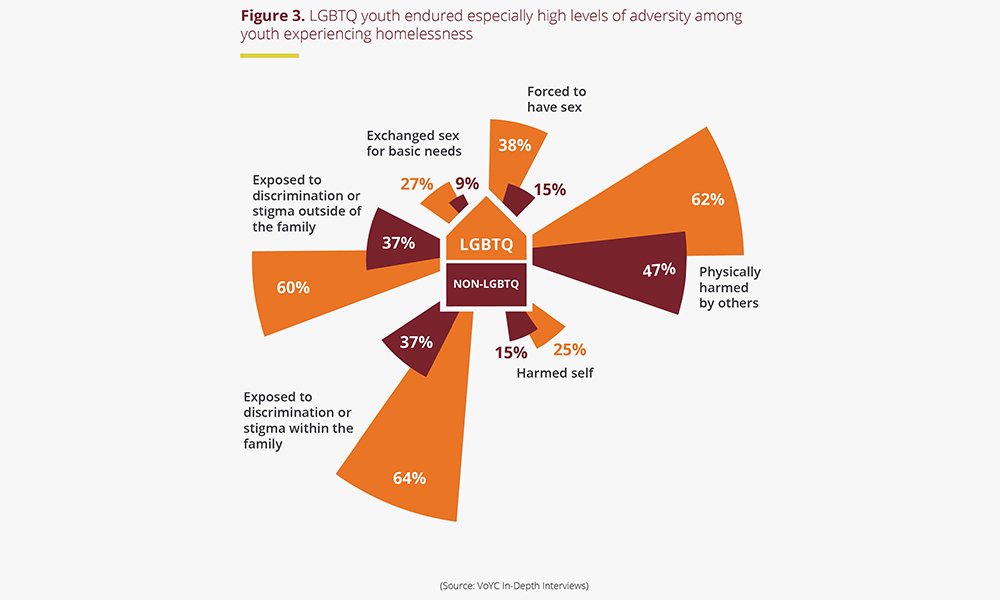WASHINGTON —Lesbian, gay, transgender, bisexual and queer youths have nearly double the risk of winding up homeless as their straight peers — and they’re twice as likely to die on the streets once they get there, a new study finds.
Homelessness amongst LGBTQ youth is highest amongst the black and brown, researchers at the University of Chicago’s Chapin Hall concluded in their new report, “Voices of LGBTQ Youth,” which was released today. Nearly one in four black or brown LGBTQ people between the ages of 18 and 25 had been homeless in the previous 12 months, researchers found.
“It really reinforces the importance of understanding the intersecting subpopulations that are at risk,” said Matthew Morton, principal researcher on the report and a fellow at Chapin Hall.
Chapin Hall has been studying youth homelessness for the better part of two years. Rather than roll its findings out in a behemoth volume, the center has been narrowing its focus to specific areas and releasing them in more digestible servings, which the center calls “research-to-impact” briefs. This LGBTQ analysis is the second of several. A report on pregnant and parenting youths is expected next month, a report on homeless youth in small towns is expected in June, and up to four others will follow in the months to come, Morton said.
Today’s findings were built not just around complex statistical analysis, Morton added. Researchers also spent hours interviewing LGBTQ youths in 22 cities about their experiences to add a qualitative dimension to the research. Among the (perhaps) surprising findings: Few reported that they became homeless because they had been cut off by ultraconservative families, Morton said.
“Very few young people had this event where they came out and then were evicted. A lot of people in the public assume that’s kind of how it happens,” Morton said.
Rather, researchers found that a young person’s coming out was just one correlative among many, including poverty, drug abuse or mental health problems in the family. “For a lot of LGBTQ, it’s a slow boil,” Morton said.
Individual experiences in report
The report’s reliance on the voices of youths themselves made it “huge,” said Nick Seip, a spokesman for the True Colors Fund, a New York-based nonprofit group that helps combat LGBTQ homelessness and that helped put together the report. “Sometimes, we forget to ask them about their expertise,” he said.
One of the voices belongs to Dee Balliet, of Columbus, Ohio. Now 28, Balliet is a gay man with African and Latin roots who has twice found himself homeless. The first time was when he was 16 and came out to his mother. He was on the streets by the end of the day. He remained homeless until his sister was able to lease an apartment under her name, just shy of Balliet’s 18th birthday.
After college, he took a job in Indianapolis but the company housing he had been led to believe was waiting for him fell apart and he found himself in a homeless shelter. The men there were older and aggressively straight. Even staff made jokes and used anti-gay slurs.
“I didn’t even feel safe sitting in the lobby. I felt more comfortable sleeping in my car,” Balliet recalled.
Balliet said he’s grateful for this report because it offers “legitimacy” to his experiences and the experiences of countless other youths like him. But he’s not waiting for the report to make an impact: He founded and helps run the National Youth Forum on Homelessness, a nonprofit group dedicated to helping youths pull themselves off the streets.
Things are better for him now, Balliet said: His mother is slowly thawing (she has marched in the last two AIDS awareness parades in Columbus; “It’s the small wins,” he said). What’s important is to make sure that this report doesn’t fall into the void. Too much depends upon it, he said.
“Yeah, there’s a lot that I’ve been through,” Balliet said. “How do we get it right for the next person?”
